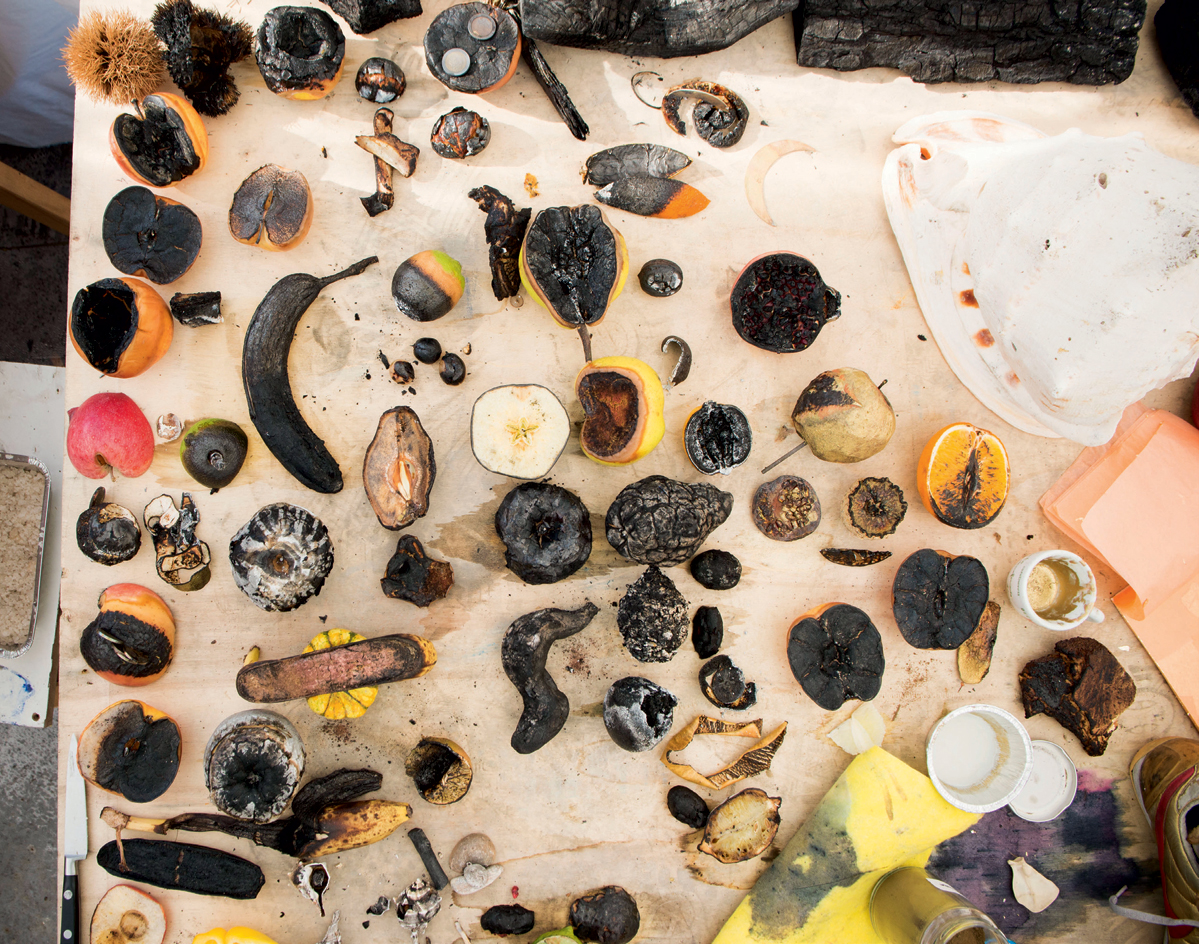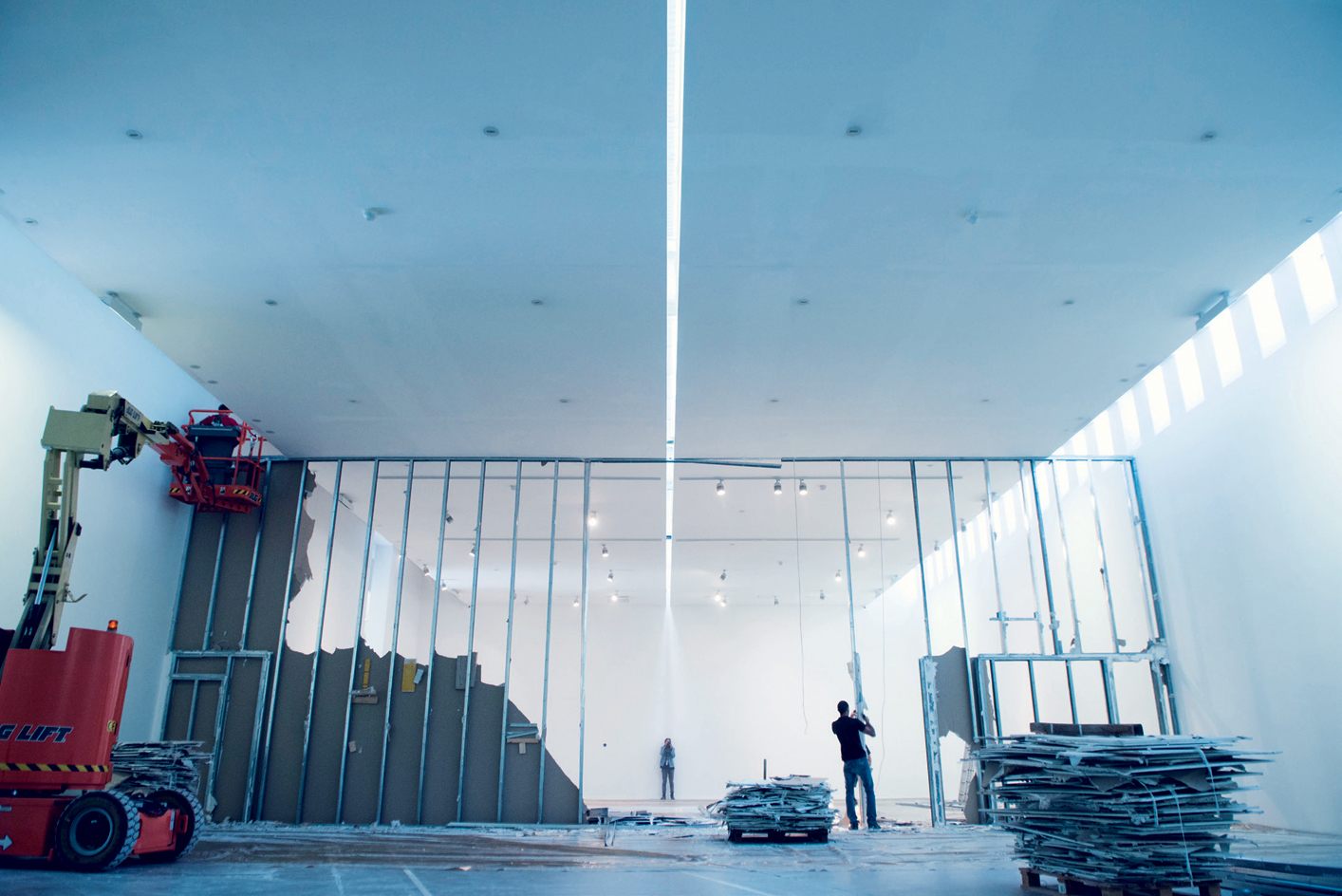Rotters' Club: artist Adrián Villar Rojas and his crew hit Turin

Rotting watermelons, putrid pumpkins and an eight-year-old cake are being flown between Argentina, Mexico and Sweden. Conservationists and curators are in a tizz. How to handle these decaying edibles, elevated to works of art by Argentinian artist Adrián Villar Rojas? What to do with their odour, their atrophy and all the potentially harmful bacteria they may harbour in the hallowed confines of a gallery?
It’s a Roald Dahl plot being rewritten by the artist who likes nothing more than causing a bit of a stink. ‘Galleries, art institutions and museums are passive containers which freeze objects,’ says Villar Rojas. ‘They are used to having things a certain way. Why not mix up the order a bit?’ It’s three weeks before his show, ‘Renaissance’, opens at the Fondazione Sandretto Re Rebaudengo in Turin. He’s wrangling with its founder Patrizia Sandretto Re Rebaudengo over the lighting. He wants it all removed, so visitors see his work in natural light only. He says: ‘Why do galleries think that unless visitors have 100 per cent light, they are not having a proper experience?’
Sandretto Re Rebaudengo counters: ‘In Turin, in the winter, it’s not light until 8am and it’s dark by 3pm.’ And anyway, he has already turned the 3,500 sq m space, designed by architect Claudio Silvestrin, upside down. The bookshop has been removed and the internal walls, signage and switches are about to go. The reception desk is being boarded up – staff will appear from behind it to sell tickets – and the whole exterior is being scrubbed with soap and water. Cleaning, wrapping and concealing – he calls it ‘disrupting the infrastructure’ – are central to his working method. ‘I would never do a project without seeing the space first,’ he says. Such is the 35-year-old’s reputation that even the art world’s top dogs bow to his demands. This autumn, Marian Goodman allowed him to cover the perimeter of her New York gallery with a grey curtain and place broken tiles all over the floor in a show entitled ‘Two Suns’. In March, for the Sharjah Biennial in the UAE, he scrubbed up the abandoned Kalba Ice Factory and placed mounds of compost around it, and this June, the Guggenheim Museum in New York allowed him to install a work on the roof of Frank Lloyd Wright’s landmark building. Villar Rojas is the first artist ever to do so, and all we know is that it’s palm-sized, and will be in the museum after we’re long gone. Staff at the museum give the artist updates on its condition twice a week.
He and his team have been in Turin for a month. Some of them are staying with Sandretto Re Rebaudengo; he likes to work like this, on site for a few weeks. ‘We are nomadic, like a travelling theatre troupe,’ he says. They all hail either from rural parts of Argentina, or Rosario in the province of Santa Fe, where Villar Rojas grew up. ‘We’re from a country far away from anywhere, and from the countryside. It gives you a hunger,’ he says. His merry band includes a philosopher/farmer, two architects, a former gas fitter, an engineer, a model maker, a jeweller and his righthand woman Noelia Ferretti, who draws out all his designs. Since they have been in the city, they have visited brick factories, taxidermists and metalworkers. They’ve bought antiques from Porta Palazzo, Turin’s famous market, and swordfish and oysters. All these experiences dictate how the installation will end up.
Villar Rojas has just returned from a huge metalworking factory in the suburbs. ‘We sat around a large table with the staff. When I explained that I wanted them to galvanise the head of the swordfish I thought they would kick us out. Instead, they were very open. In the UK, they would have said, “fuck you”. In New York the same: “We’re too busy. There’s no profit in it.”’ Testing people’s kindness, their generosity and their trust is a game he enjoys. ‘I use as many connections around me as I can,’ he says. ‘They are the forces that shape every project.’
Villar Rojas and Sandretto Re Rebaudengo properly met in 2012 at his ‘Return the World’ exhibition at Documenta 13. She bought one of his unfired clay bells from the show and as the owner of seven works is his biggest collector. Typically, he sculpts in unfired clay and cement, so the works are designed to crumble to dust. When it came to creating a show to commemorate the foundation’s 20th anniversary, Villar Rojas was an obvious choice.
We visit Beppino Occelli, an artisanal cheesemaker in the village of Valcasotto, an hour from Turin. At the entrance, we are told to put on plastic coats, hats, and mouth masks and to cover our shoes so we do not import any germs. In a dark cellar with 96 degrees humidity, cheeses that take up to two years to ripen sit on wooden shelves. Villar Rojas admires their mouldy surface, their changing states, and scrutinises their evolution like a detective at a crime scene. He’s not sure, but he might use them in the show, along with dead pigs stuffed with dead birds, sprouting potatoes and the swordfish.
Seven trucks are on their way from Turkey, carrying marble slabs and volcanic stones weighing half a ton each. They are black, green and coral-coloured and will form the bedrock of the installation. ‘I don’t have the formation of the stones in my head yet,’ he says. ‘That will happen when they are in situ, but I think it will look like a temple, or a church.’
These days, Villar Rojas ‘writes and directs’ rather than doing the manual work. ‘I take many notes along the way and create a sort of script which I read to my collaborators.’ They then interpret his words and he oversees every detail of the production process.
Their vision is a startling one – an alternative world where nature and technology, often presented as relics and ruins, meet the dark forces of decay and destruction. In 2009, Villar Rojas made a life-size clay whale, beached it in a forest in Patagonia, and called it My Dead Family. For the Istanbul Biennial this summer, he created a Noah’s Ark of fibreglass animals in the Bosphorus. Some were carrying each other, rescuers from the flood, others were weighed down by unidentifiable detritus. All had post-trauma, zombie-like gazes.
What will happen after ‘Renaissance’ closes next year? Typically, the work is destroyed after each exhibition. Villar Rojas is not keen on permanence; he has no studio, nowhere to store anything, no website and no home of his own. He’s exhausted; 2015 has been a big year, with five major shows, and he wants some time out in Rosario. He’s going to make a piece for his alma mater, the University of Rosario, where he studied Fine Arts. But he will keep the stones and maybe some of the ‘natural mutants’ from the show. Perhaps, like the sponge cake, they will end up in his parents’ fridge, conserved, he says, ‘only with love’.
As originally featured in the December 2015 issue of Wallpaper* (W*201)

Adrián Villar Rojas at the Fondazione Sandretto Re Rebaudenco in Turin, surrounded by great chunks of stone that feature in his new 'Renaissance' show.

Some of the seven truck-loads of marble and volcanic rock that were transported from Turkey to form the bedrock of Villar Rojas' installation.

Ahead of his show, Villar Rojas removed interior walls at Fondazione Sandretto Re Rebaudengo.

Organic material including fish and fruit is used to represent decay and mutation.

The gallery was designed in 2002 by Claudio Silverstrin.
INFORMATION
‘Renaissance’ is on view until 28 February 2016. For more information, visit Fondazione Sandretto Re Rebaudengo’s website
ADDRESS
Fondazione Sandretto Re Rebaudengo
Via Modane, 16
10141 Turin
Wallpaper* Newsletter
Receive our daily digest of inspiration, escapism and design stories from around the world direct to your inbox.
Emma O'Kelly is a freelance journalist and author based in London. Her books include Sauna: The Power of Deep Heat and she is currently working on a UK guide to wild saunas, due to be published in 2025.
-
 Ligne Roset teams up with Origine to create an ultra-limited-edition bike
Ligne Roset teams up with Origine to create an ultra-limited-edition bikeThe Ligne Roset x Origine bike marks the first venture from this collaboration between two major French manufacturers, each a leader in its field
By Jonathan Bell
-
 The Subaru Forester is the definition of unpretentious automotive design
The Subaru Forester is the definition of unpretentious automotive designIt’s not exactly king of the crossovers, but the Subaru Forester e-Boxer is reliable, practical and great for keeping a low profile
By Jonathan Bell
-
 Sotheby’s is auctioning a rare Frank Lloyd Wright lamp – and it could fetch $5 million
Sotheby’s is auctioning a rare Frank Lloyd Wright lamp – and it could fetch $5 millionThe architect's ‘Double-Pedestal’ lamp, which was designed for the Dana House in 1903, is hitting the auction block 13 May at Sotheby's.
By Anna Solomon
-
 For these female photographers, the body is a tool of political dissent
For these female photographers, the body is a tool of political dissentThe work of Liliana Maresca and Gundula Schulze Eldowy, who both lived in political turmoil, was celebrated at this year’s Artissima art fair in Turin. Discover their work here
By Finn Blythe
-
 Artissima 2022: art exhibitions to see this weekend in Turin
Artissima 2022: art exhibitions to see this weekend in TurinTurin art fair Artissima 2022 spans the experimental and the perspective-bending; here’s what to see
By Martha Elliott
-
 Star gazing: Adrián Villar Rojas hides a constellation of works at Athens’ Observatory
Star gazing: Adrián Villar Rojas hides a constellation of works at Athens’ ObservatoryBy Jake Cigainero